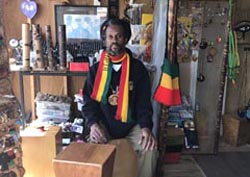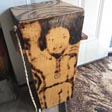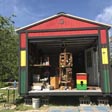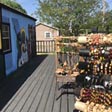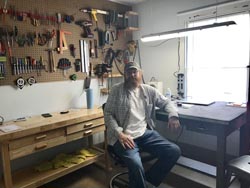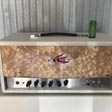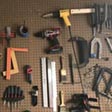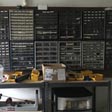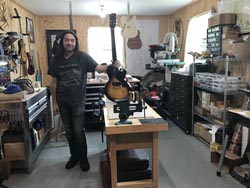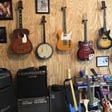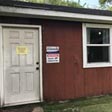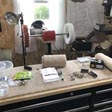Innovation, Tradition, and Change in Louisiana Musical Instrument Making and Repair
By Holly Hobbs

Baton Rouge
Steven Sheard, West African diasporic drum building/repair
Drum maker Steven Sheard lives in Baton Rouge and operates the We3Kings Cultural Corner store (along with two other business partners), located near Southern University at 1088 Swan Avenue. The store sells his drums, African history books, some imported African items of clothing, incense, and wooden and leather jewelry Steven makes. Steven also makes traditional Afro-Cuban cajón drums, although he decorates them with his own style and uses a flame torch to create decorations on the wood via fire.
Steven Sheard grew up in Pasadena, California, to a pianist mother from Jennings, Louisiana. Of his childhood memories of Louisiana, Steven says "it felt like a whole other country." Because of his family's Louisiana background, Mr. Sheard went to Southern University in Baton Rouge for college and ended up setting up a permanent home here. There is a strong disconnect between the Southern University and the surrounding community of Scotlandville, he says, and it remains deeply segregated from Baton Rouge.
Drums were his first instrument, although he did not start playing until he was in his 30s. He began on the djembe, taking a class in West African drumming to help him learn. A friend introduced him to the cajón , the traditional Afro-Cuban/Afro-Peruvian drum, and he was immediately taken by it. Mr. Sheard had always been a craftsperson and a wood carver and has long made jewelry and other items out of wood and leather. His father was also a woodworker and craftsperson, and Steven learned a great deal by watching him growing up. So he set out to make a cajón, and quickly found deep satisfaction in this work of creating multiple drums, decorated with his own designs that he sells out of his store that he shares with his business partners. He prefers birch and plywood as materials and makes all different sizes of drums with different variations of decoration and painting. Some are natural wood; others are fully painted. He describes the different pitches you can get out of the different shapes and sizes of his drums. He sells them in his store and at local crafts and arts festivals for about $60 and up, depending upon the size and extent of decoration.
Steven talks more about the decoration:
Well I do a lot of wood burning with the stuff I make. A lot of times I'll see images or ideas in a piece of wood and I just kind of highlight it with the fire. Like the image of the woman, her face and stuff and the shape of her body was pretty much in the grains of the wood. So I kind of highlighted it with the fire and came up with the face and other things like that.
So I'll see images in other grains of wood and bring it out with the fire, you know. The wood burning, the outer part is mainly done with a torch, a propane torch, and then I also for the more detailed stuff, I have a wood burning tool for detail work, similar to a soldering iron. It heats up different tips, you can control the line and thickness like that.
He says it is a medium that's hard to work with.
Yeah, well, there's no erasing, put it that way. You have to go with, once you burn it, there's no going back over it, like paint, you can always paint over and change stuff, but with wood burning, pretty much once you've done the line, it's there. Not too much you can do to erase. So that can be an issue.
The many concentric circles in his design work are his preferred motif, he says. "The spiral and circles on top kind of represent the sound vibrating, the sound waves."

Holger Notzel, Guitar/tube amplifier builder/repair/shop
Guitar builder/repairer and amp builder Holger Notzel is a German-born artist who has lived and worked in Baton Rouge for decades. Further interested in creating a sound that was more accurate to acoustic instruments, he began to build tube amplifiers, which eventually morphed into the international business, Komet Amps. He has now moved from the music store he owned with his business partner into his own workshop in Baton Rouge, located at 4262 Perkins Road. He discusses his building and repairing work history in detail.
Holger Notzel started playing guitar as a teenager in Germany, influenced greatly by American blues traditions. He attended Louisiana State University for college, which is what initially brought him to Louisiana. He has remained since that time, operating Riverfront Music store in Baton Rouge with his partner, Mike Kennedy, which was initially located in downtown Baton Rouge prior to moving to its current location on Dallas Drive. He is pessimistic about not only the future of music shops, but also the future of instrument performance, because digital technology is improving so quickly that there will come a time when even he, he says, won't be able to tell whether an instrument is acoustically or digitally played.
Holger Notzel began by building and repairing electric guitars, but slowly began experimenting with building tube amplifiers. The amps became quickly successful within their large community of musicians and friends. He first talks about his electric guitar-building aesthetics.
I generally strive to do stuff that is original. Because there is this huge market out there in guitars that copies existing designs. because guitar players are incredibly conservative, for some reason. The classic guitars were all established in the 1950s. You've got your Fender Stratocaster, Gibson Les Paul and that's pretty much it really, right there. And if it doesn't look like one of those, the guys won't even look at it. They want something that looks like what their idols played, their rock star idols played.
And that really never did appeal to me, because for one thing, it's a very crowded market and it's boring. . . . So I wanted to do something that's more unique, that's my design, that doesn't look like anything else out there, so that's always been my focus. The downside of that is you don't get the big numbers, because it's hard to convince people to try something new, and you have to get people to know about you. And with acoustic guitars it's the same situation.
Wood, he says, even though it may be cut into an instrument, is still a living thing that changes over time. Wood today, he continues, is a difficult issue because the previous standards—Brazilian rosewood and mahogany—are virtually all gone. Brazilian rosewood has been logged to near extinction, and the vast majority of mahogany is now all farmed, meaning that there are virtually no old growth mahogany trees available to builders. There is a difference in sound, he says, between the old growth trees that had animals living in them and had to compete for food and sunlight, and the sound made by the farmed trees today, which are forced to grow quickly under unnatural conditions.
Holger Notzel spends lots of time focusing on the old ways of doing things but experimenting with his own innovations. He talks about painting and varnish:
I'm in the process of rethinking [paint colors for his built guitars] right now. The traditional finish on guitars is nitrocellulose lacquer, which is a very beautiful finish. It ages very beautifully, but it's very, very toxic to work with, because it's full of volatile chemicals and it gasses off all kinds of chemicals for years really, even after it's dry. And I'm just completely trying to get away from that altogether. To the point that I don't do finish work at all anymore personally. I used to do it and it's not worth the health risk to me. There are ways to do it safely, but they're very expensive. You would have to have a completely environmentally controlled spray booth where people wear suits and you have forced air extraction and all that kind of stuff.
I'm trying now to get away from that and do more naturally based finishes, because there's some really really cool old school stuff, for instance what I really love is French polish, which is shellac. Shellac is a natural product that's produced by a tree, by a little bug that lives on the tree and they collect the droppings of that and dissolve it in alcohol. It's not just environmentally friendly, but it's friendly to the person working it and the person playing it. . . . I use Everclear, because the de-natured alcohol you can buy in the store has stuff added to it so that alcoholics won't drink it, so it's got these chemicals in it that make it smell and taste very bad, to discourage people from drinking it. But that means you have to breathe that stuff all the time while you French polish. So when you use real alcohol like Everclear, you just get alcohol fumes off of it, but that evaporates very quickly and a day later there's no smell left.
The only other thing you need for shellac is olive oil as a polishing agent, and pumice, . . . that's it. And then you can do these old school really, really beautiful polishes with it. You're limited as to the colors, . . . but that's it. . . . But that's what I'm trying to do, to build guitars that don't have all that chemical stuff in them anymore.
He discusses whether there's a through line to all of the various work that he does, and what is it about electronic sound that captivates him:
I'm just as fascinated with acoustic sounds, maybe more so. I would actually say it's the other way around. There's something inherently beautiful in an acoustic instrument, a good acoustic instrument, that that's what influences me to make electronic stuff, that kind of natural feel to it that a good acoustic instrument has.
There's something about a natural sound made by natural materials that I don't know why that is, whether it's biology or the way we evolved, but whether it's two rocks that you bang together or two sticks, there's something about the sound of natural materials that are pleasing to the human ear. And that is really what I'm trying to capture. And in a way, a tube amp is sort of like a natural instrument because you've got natural materials in there, . . . whereas you get into the digital realm, . . . all you're doing is just trying to simulate a natural sound. Whereas I try to come from the other side.

Jeff Richard, Fretted instrument repair/shop owner
Jeff Richard is a fretted instrument repairer who maintains a repair workshop called The Fret Shack, located in Baton Rouge. He says that business increases every year, and 2018 has been his most successful year yet.
Growing up in Baton Rouge, Jeff Richard's first instrument was the viola, but he fell in love with electric guitar as a teenager, which soon became his life's passion. It was his first electric guitar that provided entrée to his future as an instrument repairer. He would take the instrument apart, and put it back together, experimenting with different ways of making better sounds. He later went to repair school in Michigan, and while working in journalism and media for several papers and for the State of Louisiana, he was also buying, repairing, and selling guitars on the side. It had long been his dream to open a repair shop, and his wife suggested that he finally open the shop in 2015. Because he had a strong community of fellow musicians, and because of his background in media, he was able to quickly develop a following of guitar enthusiasts online, which contributed to his client base.
Jeff Richard works on all instruments with frets, saying that it is fret work that is most interesting and meaningful to him. "Fret work makes or breaks a guitar," he says. He doesn't have any interest in building, but much of what he does is full refurbishment of vintage instruments. He states that "the traditional music store is gone and it's not coming back." He feels that online resources are perfectly adequate for new players starting out to find instruments that are best for them, and that music stores are no longer particularly needed. He, of course, makes an exception for repair shops and building shops, which he says are absolutely integral to creating and maintaining community.
Like Holger Notzel, he talks about the changes in available wood over time, and the ways in which the wood used is absolutely essential to creating the type of sound one desires. He also laments what he sees as a throw-away culture, aiming instead for refurbishing old things and adapting new things so they last a century, rather than a decade. He continues:
This Gibson that just came to me, . . . it's a 1955 Les Paul. It looks brand new. I did a full restoration on this guitar. . . . When I got this guitar, it was rattle can spray painted egg yolk yellow. And it had a Zip Lock bag with more parts missing than were there of the original parts. I did a full restoration on it, and because it was in such pitiful shape, I was able to take a little poetic license with it. It looks . . . back to 1955. These machine heads are cutting technology as far as what is going on with the gearing. It just looks 70 years old. This tail piece looks period correct mid-50s, but it is actually aircraft-grade aluminum and it has some other stuff going on in there to help with the tuning. This pickup looks 70 years old, but again, it's a little hot-rodded by a custom winder out on the West Coast. Anyway, a real phoenix-from-the-ashes type thing.
Jeff Richard also makes or adapts his own tools to better suit his needs, bringing true art and creativity to the act of repairing instruments. He states:
I'm not a builder. I'm not a luthier. I tell people, I'm a fixer. Don't give me a tree and expect me to turn it into a guitar. Where I come into play is, you bring me something that I take to its fullest potential. Give me that bad kid and let me turn him into a Rhodes Scholar, kind of thing. . . . I think the coolest thing, I think this is more than just the guitars, I think it has to do with musical instruments in general, is that there's a lot of cool things going on from the idea, it's a cool mix of artistic stuff, artistry, the expression of the person who built it, and the same time there's physics, there's engineering.
Kind of like I told you about that acoustic, we can talk about the intricacies of mother of pearl inlays on Brazilian rosewood. We can talk about the idea of multi-ply binding and what that entails, . . . that multi-ply binding is extremely work intensive. Or like this artwork that I had to restore in here, that little hummingbird [on a guitar] and the flowers and all that, I had to put all that back on there. But like I told you, this is an explosion waiting to happen, it's a hollow box with high-strung wires on it. And it will eventually collapse, no question about that. You could have the nicest built guitar in the world, and it's eventually going to need a neck reset. And that's where a guy like me comes in.

Conclusion
Two central themes—that of a passion for the work (a calling, in many cases, that developed organically but quickly became a life's work) and that of the importance of longevity and repurposing existing materials—arose as the primary through-line that connected all artists' stories. Also central was the importance of maintaining the old ways in the face of change but innovating upon them to better maintain the aesthetics of tradition, as the artists and their communities themselves define it.
Don Teach taught himself to build his own piano parts for old player pianos and severely damaged vintage pianos, finding value in restoring things that would otherwise be lost. Gladys Miller creates her canjos through a careful process that is both fulfilling and of use to a community of children around her. Benjamin Strange and Aaron Younce pronounce, through their guitar work, that they want their customers to know that anything can be fixed. Wesley Phillips teaches children the art of repurposing materials to create traditional drums in new ways. Sal Giardina spends his days restoring stringed instruments, using old technologies, like Everclear varnish, to improve upon his work. Frank D'Arcangelo discusses the changes in the music store business over time, and that nothing can compare to holding an instrument in your hands for the first time to see how it feels to play. Charles Lumar is dedicating his life to creating innovations in double bass building that better suit the individual player and to provide resources for low-income families to have better access to instruments. Henry Artigue finds a love of sound in all that he does in his piano work. Raymond Reyes finds joy in building traditional drums that can be played by his community members and connect him to the environment. Rickie Monie describes a life of love for old ways and old things, and the mechanics of complicated parts.
Dexter Ardoin's father's accordion is his prized possession, as he notes that the older the reeds, the more beautiful the sound. Junior Martin finds joy in working with wood, creating an original instrument out of raw materials that serves his tradition. Max Theriot finds joy in careful details, working slowly and methodically to create the best sound out of brass and woodwinds. Tom Pierce holds jam sessions at his violin shop to aid in building a sense of community around his store. Jay Steiner notes the importance of innovation in maintaining tradition, through his innovative work with traditional triangle building. Jason Harrington uses old tube amplifier technology to better replicate the acoustic sounds of his instruments. Anya Burgess uses her classical training to create violins with precision and longevity in mind. Steven Sheard creates designs that emerge to him from the grains in the wood of his drums. Holger Notzel uses old technologies to better improve upon electric sound to create natural equilibrium. Jeff Richard finds happiness in his repair work of fretted instruments, finding his most authentic self in repair and restoration and making old things come alive.
All artists involved with music stores were largely hopeful about maintaining their business due to scaling down their inventory, matching prices online, offering excellent personal customer service, offering rentals and lessons, and offering a community space that could serve a gathering space for customers to discuss and learn. While all assert that the days of the mom and pop music shop are largely over, and that the Internet has caused a decline in business in general, they also assert that the ways listed above, along with a scaling down of a standard music shop in favor of one that focuses more on personalized building and repair, creates a path toward a more optimistic and sustainable future.
All artists asserted that innovation was absolutely integral to the maintenance of tradition. Keeping old ways alive is not antithetical to progressiveness and change and in fact, as many assert, they are one in the same. All remain hopeful about the future of their work.
At the heart, this project seeks to serve as an asset to the musicians, builders and repairers whose artful, passionate and joyful stories are detailed above, along with the countless other customers, clients and fellow musicians, friends and family that support them. Information is an artist's best resource, next to the art that exists within them. Helping to connect people and communities and assisting in dispelling the myth of a dying tradition will hopefully be of direct benefit today and in the coming years that lie ahead, serving not only to link musicians with instrument makers, repairers and restorers, but to better connect the artisans themselves with each other.
Sources
Ardoin, Dexter. 2018. Personal Interview. Scott, Louisiana. April 24.
Artigue, Henry. 2018. Personal Interview. New Orleans, Louisiana. April 17.
Burgess, Anya. 2018. Personal Interview. Lafayette, Louisiana. April 14.
D'Arcangelo, Frank. 2018. Personal Interview. Kenner, Louisiana. March 26.
Giardina, Sal. 2018. Personal Interview. New Orleans, Louisiana. March 22.
Harrington, Jason. 2018. Personal Interview. Lafayette, Louisiana. April 14.
Lumar, Charles. 2018. Personal Interview. New Orleans, Louisiana. April 5.
Martin, Jr., Clarence "Junior." 2018. Personal Interview. Scott, Louisiana. April 13.
Miller, Gladys. 2018. Personal Interview. Alexandria, Louisiana. March 31.
Monie, Rickie. 2018. Personal Interview. New Orleans, Louisiana. April 23.
Notzel, Holger. 2018. Personal Interview. Baton Rouge, Louisiana. April 20.
Phillips, Wesley. 2018. Personal Interview. New Orleans, Louisiana. March 21.
Pierce, Tom. 2018. Personal Interview. Arnaudville, Louisiana. April 13.
Reyes, Raymond. 2018. Personal Interview. Port Sulphur, Louisiana. April 18.
Richard, Jeff. 2018. Personal Interview. Baton Rouge, Louisiana. April 20.
Sheard, Steven. 2018. Personal Interview. Baton Rouge, Louisiana. April 20.
Steiner, Jay. 2018. Personal Interview. Lafayette, Louisiana. April 14.
Strange, Benjamin and Aaron Younce. 2018. Personal Interview. New Orleans, Louisiana. March 15.
Teach Don. 2018. Personal Interview. Shreveport, Louisiana. March 30.
Theriot, Max. 2018. Personal Interview. Lafayette, Louisiana. April 13. March 21.


